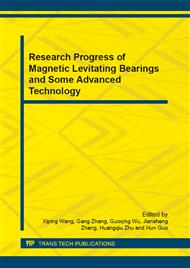p.40
p.45
p.50
p.57
p.63
p.69
p.75
p.80
p.85
Influence of Suspension Mass Variation on Dynamic Characteristic of Magnetic Suspension System
Abstract:
Magnetic suspension system is nonlinear and unstable essentially. It is according to the principle of nonlinear system having same topological structure near the operation point with the linear system that linear control arithmetic for a nonlinear system is adopted. The system is easy to lose stabilize and diverge when subjected to interference or system parameters variation. Suspension mass is a key parameter of a magnetic suspension system and suspension mass variation has great influence on the dynamic characteristic of a magnetic suspension system. The influence of suspension mass variation on the dynamic characteristic of a magnetic suspension system under the PID control condition is discussed. The relationship between dynamic characteristic and structure as well as control parameters of the magnetic suspension system is reached by means of experimental method.
Info:
Periodical:
Pages:
63-68
Citation:
Online since:
January 2012
Authors:
Price:
Сopyright:
© 2012 Trans Tech Publications Ltd. All Rights Reserved
Share:
Citation:


